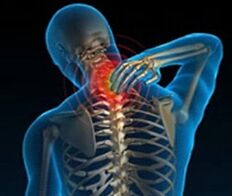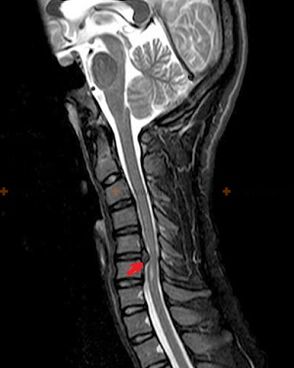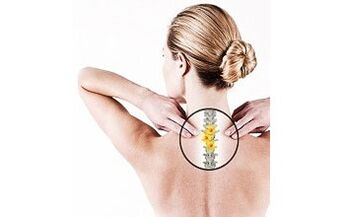Cervical osteochondrosis (cervical osteochondrosis) is a chronic degenerative disease of the spine, in which the vertebral structure is distorted, the integrity of the intervertebral structure is disturbed, and the spinal cord root is damaged.

Important to know!Osteochondrosis is not a death sentence.Often there is an opportunity to relieve the severity of the process, as well as control the development of changes in the spine.In the most advanced cases, neurosurgical operations are possible.However, this does not negate the fact that the disease can be "triggered."It is very important to consult a doctor when the first symptoms of osteochondrosis appear to diagnose the disease and prescribe early preventive measures!
Because of development
The anatomical structure of the spine suggests the greatest mobility in the cervical spine, and it is in the cervical spine that the vertebrae are the smallest.These two factors make the neck one of the "weak points" of the spine.
The main reason for the development of osteochondrosis of the cervical spine is a combination of the following unfavorable factors:
- Improper posture and neck position (including when working at the computer) ..
- High physical load on the cervical spine and shoulder girdle.
- Spinal cord injury...
- Age-related changes in intervertebral structural tissue.
- Wrong diet, low in essential vitamins and minerals.
It must be said that almost everyone develops osteochondrosis with age;According to some researchers, it is "a kind of payback for walking upright."However, in the modern world, with its fast life, sedentary lifestyle and prolonged work at the computer, it is cervical osteochondrosis that comes out on top of spine problems.
Symptoms
Symptoms can vary depending on the degree of damage to the spine, the severity of degenerative changes, the individual characteristics of the human body and many other factors.Neurologists prefer to distinguish three main symptom complexes that occur with cervical osteochondrosis, as well as their combination:
- Vertebrogenic cervicalgia.
- Vertebrogenic cervicocranialgia.
- Vertebrogenic cervicobrachialgia.
Based on the names, we can identify the main symptoms of cervical osteochondrosis.Therefore, with Cervicalgia, the main complaint will be pain directly in the neck;With vertebrogenic cervicocranialgia, pain in the neck also spreads to the head;With Cervicobrachialgia, pain in the neck spreads to one or both arms, spasms in the arms also develop, numbness and a feeling of crawling in the arms may appear.In all cases of osteochondrosis, the following symptoms may appear: tension in the neck muscles, digging in the neck, limitation of movement in the neck.
Radiculopathy
In the presence of severe osteochondrosis, complicated by the presence of protrusions or disc herniations, the so-called radiculopathy can form: functional disorders of certain spinal roots with the development of impaired muscle weakness, weight loss, and sensitivity disorders.
Diagnostic Signs and X-Rays
Osteochondrosis is an X-ray diagnosis, because a detailed clinical picture is available only at the moment of severity, while changes in the spine can occur with a person's subjective well-being.Without an X-ray examination, we can only talk about suspected osteochondrosis, because the same symptoms can be caused by other diseases (myositis, vertebral neoplasm, etc.).

To diagnose osteochondrosis, the following research methods are used: Radiography (better with functional tests), MSCT and MRI.The latter study is the most preferred due to the fact that it allows one to clearly describe the state of the intervertebral structure.
X-ray signs of osteochondrosis include the following changes in the spine:
- Reduces the height of the intervertebral disc.
- Presence of marginal bone growth.
- Violation of the location of the vertebrae relative to each other.
- Deformation of the vertebral body and arch, etc.
The presence of the changes described above, as well as changes in the structure of the intervertebral disc, detected by MSCT and MRI, serve as reliable signs that confirm the presence of osteochondrosis.
Treatment
Treatment should be comprehensive and aimed at all aspects of the pathogenesis of clinical manifestations.Chronic dystrophic changes during exacerbation cause inflammation of the spinal cord root, which in turn reflexively causes pain.Pain is a signal for the muscles to develop a protective response - muscle spasm.Muscle spasms bring the vertebrae closer together and increase compression (compression) and root inflammation.The circle is closed.That is why it is necessary to eliminate inflammation, pain, and muscle spasms, and protect the roots from the effects of inflammation.

There are medical and non-medical treatment methods.They change in part with the presence of certain symptom predominance, but they have a general pattern.
Medicines
Anti-inflammatory drugs (aceclofenac, ketoprofen, meloxicam, diclofenac, etc.), muscle relaxants (Tolperisone hydrochloride, baclofen, tizanidine), neuroprotective drugs (vitamin b complex preparation and thioctic acid) are used.
Not drugs
Includes massage, physiotherapy and exercise therapy.Massage for cervical osteochondrosis very effectively relieves muscle spasms, increases blood flow to the spinal tissue, which reduces the severity of the inflammatory process.Physiotherapy can be aimed at relieving pain (electrophoresis with analgesics) and relieving muscle tension (diadynamic current).Therapeutic exercise is a unique and highly effective method of disease prevention.You can see a set of exercise therapy exercises for cervical osteochondrosis here.
People's recovery
Among the traditional treatment methods, we should highlight the use of various warm-ups based on water and alcohol, which can reduce the intensity of neck pain and reduce inflammation.The "dry heat" method is also well proven, the essence of which heats salt or sand placed in a cloth bag and then applied to the site of pain.
Some traditional methods of treating osteochondrosis of the cervical spine include the use of applicators - special devices or just the tissue surface covered with needles.Applying moderate pressure to the neck area, as well as just lying on such a surface for 10-15 minutes, causes reflexive relaxation of the cervical muscles and relieves pain.






















